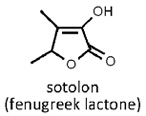 Trigonella foenum-graecum
Trigonella foenum-graecum
fenugreek
Back to “Salad herbs and herb mixtures: fenugreek (Trigonella foenum-graecum)”
Back to “Culinary herbs: fenugreek (Trigonella foenum-graecum)*”
Back to “Spices: fenugreek (Trigonella foenum-graecum)s”
Trigonella foenum-graecum L. (Fabaceae); fenegriek (Afrikaans); abish (Amharic); hulba, hilbeh (Arabic); hu lu ba (Chinese); fenegriek (Dutch); fénugrec (French); Bockshornklee (German); trigonella (Greek); methi (Hindi); fieno greco (Italian); koruha, fenu-guriku (Japanese); horopa, penigurik (Korean); halba (Malay); alholva, fenogreco (Spanish)
DESCRIPTION Fenugreek herb is the fresh or more often dried stems and leaves and have a sweet aroma like hay. Fenugreek spice is the ripe seeds, small and bean-shaped but angular, usually beige or various shades of brown and green. They have a bitter taste and strong smell that becomes more caramel-like when the seeds are roasted and crushed.
THE PLANT A sparse erect annual of about 0.6 m (2 ft) high bearing trifoliate leaves with toothed margins and small white flowers. The fruits are narrow, flat pods with long, slender tips, each producing up to 20 seeds.
ORIGIN Indigenous to the eastern Mediterranean and the Near East.1 Fenugreek has been grown since ancient times (e.g. by the Assyrians) for food (used like lentils), medicinal purposes (e.g. to stimulate lactation) and as a fodder plant (foenum-graecum means “Greek hay”). Charred remains of seeds dating from 4000 BC have been found at Tell Halaf in Iraq and seeds were also found in Tutankhamen’s tomb (1325 BC).1 It is an important spice and pulse in Ethiopia, the Middle East, China and India.2 The central European blue fenugreek (T. caerulea) is important in traditional Georgian cooking.3
CULTIVATION Fenugreek is easily grown from seeds in dry temperate and subtropical regions.
HARVESTING Harvesting is done mechanically or by hand. The Hindi names of the products are methi (seeds), sag methi (fresh leaves) and kasuri methi (dried leaves).2 The last-mentioned has become freely available in supermarkets in cosmopolitan cities with large numbers of people of Indian origin.
CULINARY USES Fenugreek is used mainly as a spice. Roasted and ground seeds are ingredients of pickles, chutneys, spice mixtures and curry powders (e.g. Indian sambar podi and Bengali five-spice powder or panch phoron, comprising fenugreek, brown mustard or radhuni, cumin, kalonji and fennel) and vegetable stews and sauces (e.g. Ethiopian shiro and Yemeni hilbeh). The fresh or more often dried leaves are used in North India (e.g. in naan bread and vegetable curries), Turkey (e.g. vegetable and meat stews) and Iran (e.g. in Persian ghormesabzi and a mutton khoresht made from it).2 Blue fenugreek is called utskho suneli in Georgia.3 The dried and powdered herb is an important component of the Georgian spice mixture known as khmeli suneli but can be substituted with fenugreek.3
FLAVOUR COMPOUNDS The strong flavour of roasted fenugreek is due to sotolon (4,5-dimethyl-3-hydroxy-2[5H]-furanone), also known as fenugreek lactone.4,5 This powerful aroma-active compound is also found in lovage, coffee, artificial maple syrup and molasses and has a detection threshold of 0.001 parts per billion.5 Also present are volatile compounds such as 2-methyl-2-butenal, δ-elemene and hexanol.4

NOTES In Indian cuisine, fenugreek is used as a vegetable in the form of sprouts, microgreens and whole young plants.
1. Zohary, D., Hopf, M. 2000. Domestication of plants in the Old World (3rd ed.). Clarendon Press, Oxford.
2. Gernot Katzer’s Spice Pages (http://gernot-katzers-spice-pages.com).
3. Margvelashvili, J. 1991. The classic cuisine of Soviet Georgia. Prentice Hall Press, New York.
4. Mazza, G., Di Tommaso, D., Foti, S. 2002. Volatile constituents of Sicilian fenugreek (Trigonella foenum-graecum L.) seeds. Sciences des Aliments 22: 249-264.
5. Blank, I., Schieberle, P. 1993. Analysis of the seasoning-like flavour substance of a commercial lovage extract (Levisticum officinale Koch). The Flavour and Fragrance Journal 8: 191–195.